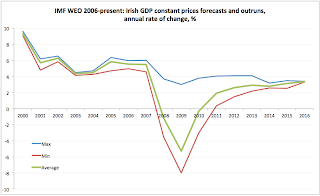Since the disastrously vacuous summit last Thursday and Friday, there has been a barrage of 'Ireland is special' statements from Merkel and other political leaders. The alleged 'special' nature of Ireland compared to Greece, Portugal and Spain is, supposedly, reflected in Irish banks being successfully repaired and Irish fiscal crisis corrected to a stronger health position than that of the other peripheral countries.
I am not going to make a comment on the banking system's functionality in Ireland compared to other states. But on the fiscal front, let's take a look. Per IMF:
- In 2012 we expect to post a Government deficit of 8.30% of GDP against Greece's deficit of 7.52%, Portugal's 4.99% and Spain's 6.99%. We are 'special' in so far as we will have the highest deficit of all peripheral countries.
- In 2013, Ireland is forecast to post a Government deficit of 7.52% of GDP against Greece's 4.67%, Portugal's 4.48% and Spain's 5.67%. Once again, 'special' allegedly means the 'worst performing'.
- In 2012, Ireland's structural deficit would have fallen from 9.31% of potential GDP in 2010 to 6.15% - a decline of 3.16 ppt. For Greece, the same numbers are 12.12% to 4.53% - a decline of 7.59 ppt or more than double the rate of austerity than in Ireland. For Portugal, these numbers are 8.96% to 4.09% - a decline of 4.87 ppt of more than 50% deeper reduction than in Ireland. For Spain: 7.32% to 5.39% - a drop of 1.93 ppt or shallower than that for Ireland.
- In 2013 in terms of structural deficit, Ireland (5.38% of potential GDP deficit) will be worse off than Greece (-1.06% of potential GDP), Portugal (2.28%) and Spain (3.52%)
Now, run by me what is so 'special' about Ireland's fiscal adjustment case?
Can it be that we are 'lighter' than other peripherals on debt?
- 2010 Government debt in Ireland stood at 92.175% of GDP and this year it will be around 117.743% - up 25.255% of GDP. For Greece this was respectively 144.55% of GDP in 2010 and 170.731% in 2012 - a rise of 26.181%, marginally faster than that for Ireland. For Portugal, gross Government debt was 93.32% of GDP in 2010 and that rose to 119.066% in 2012, an increase of 25.746%. Again, not far from Ireland's. And for Spain, these numbers were 61.316% to 90.693% - a rise of 29.377%. So while Spain is clearly the worst performer in the class, Ireland, Greece and Portugal are not that far off from each other.
Wait, what about economic reforms and internal devaluations? Surely here Ireland, with its exports-focused economy is a 'special' case?
- In 2012, Ireland is expected to post a current account surplus of 1.813% of GDP, against deficits of between 0.148% and 2.909% for the other three peripheral countries. This, of course, is not the legacy of Irish reforms, but of the MNCs operating from here.
- However, in terms of current account dynamics, Ireland is not that special. Between 2010 and 2012, Greece will reduce its current account deficit by 4.294 ppt, Ireland will improve its external balance by 0.674 ppt, Portugal by 7.105 ppt and Spain by 2.278 ppt. So Ireland is the worst performing country of four in terms of current account dynamics, while the best performing in terms of current account balance.
Now, do run by me what can it possibly mean for Ireland to be a 'special' case compared to Greece, Portugal and Spain?




